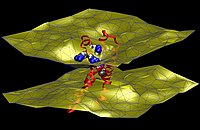Neutron diffraction

Hi there! Do you know what atoms are made of? They have a lot of tiny particles inside them called protons and neutrons. Neutrons are especially interesting because they don't have any electric charge, which means they can go right through a lot of things, like rocks and metal.
Scientists use something called neutron diffraction to study how neutrons bounce off of different materials. They shoot a beam of neutrons at a material and then detect how the neutrons scatter or bounce off of it. By analyzing how the neutrons scatter, scientists can figure out some really cool things about the material they're studying.
For example, they can figure out the structure of a material. Think of a structure like a building - it has walls, floors, and rooms in specific places. The same goes for a material! Neutron diffraction can tell scientists how the atoms are arranged in the material, providing important information about its properties.
Neutron diffraction can also help scientists study how different molecules move and interact with each other. This is really important for understanding chemical reactions and how materials behave under different conditions, like high pressure or temperature.
So basically, neutron diffraction is a special tool that scientists use to shoot neutrons at materials and see how they bounce off. By analyzing that data, they can learn a lot about the material's structure and properties. Cool, huh?!
Scientists use something called neutron diffraction to study how neutrons bounce off of different materials. They shoot a beam of neutrons at a material and then detect how the neutrons scatter or bounce off of it. By analyzing how the neutrons scatter, scientists can figure out some really cool things about the material they're studying.
For example, they can figure out the structure of a material. Think of a structure like a building - it has walls, floors, and rooms in specific places. The same goes for a material! Neutron diffraction can tell scientists how the atoms are arranged in the material, providing important information about its properties.
Neutron diffraction can also help scientists study how different molecules move and interact with each other. This is really important for understanding chemical reactions and how materials behave under different conditions, like high pressure or temperature.
So basically, neutron diffraction is a special tool that scientists use to shoot neutrons at materials and see how they bounce off. By analyzing that data, they can learn a lot about the material's structure and properties. Cool, huh?!
Related topics others have asked about:
